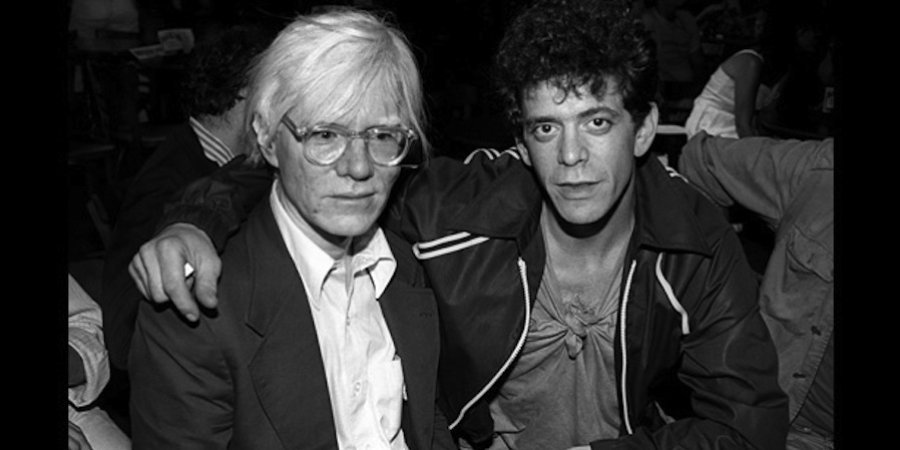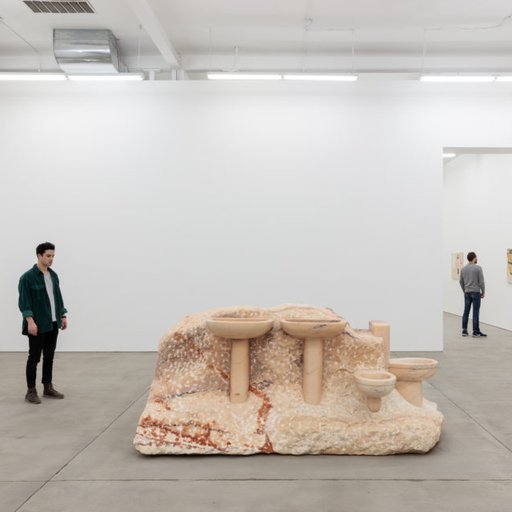Lou Reed, who passed away on Sunday at age 71, was more than a musical icon—he was, for many people, an artistic liberator, a cultural trailblazer, and, to borrow from Camus, a homme révolté in the best way. His iconoclasm and refusal to accept what he was given, be it traditional musical forms or societal constraints, was contagious among his peers and admirers, and beyond the legend that everyone who bought a copy of "Velvet Underground & Nico" in 1967 went out and started their own band. He had a indelible impact on the art world too.
From his early days as a star player in the circle of Andy Warhol, who matched his band with the Swedish chanteuse Nico and svengalied him into the limelight (and whose Factory he immortalized in "Walk on the Wild Side"), Reed was deeply invested in art, even as he refused to accord it any special status above the rock-n-roll songs he swore by. As his career evolved, he stepped further into the fine-art arena with "Metal Machine Music"—his 1975 record that took the sonic experiments of John Cage and La Monte Young to raw, uncompromisingly unpleasant extremes—and later with his photography, which he exhibited in galleries and museums around the world.
Along the way, he entered into the lives of a broad spectrum of artists, curators, and critics, often meeting them through his longtime lover Laurie Anderson (whom he married in 2008) or at the gallery openings he would occasionally attend, lifting up the lenses on his custom-made glasses to peer at the art. To pay tribute to Reed's legacy in the art world, we spoke to a number of artists, architects, and curators who benefited from his unique brand of tough love.
CLIFFORD ROSS, Artist
Lou came into my life not on a pedestal, but at ground level. He was a New York icon, but I met him in a very relaxed way in the early '90s when he was with Laurie Anderson, an old friend. For a guy who was famous for being grouchy, he sure was sweet.
He had seen it all, and it showed. A hug from Lou always came with an extra, emphatic squeeze that somehow conveyed, “I get you. (And I love you anyway.)” He always gave his friends a perfect day. Forgive the transposition, but he made me forget myself, and to think I was someone else, someone good.
Lou was a magician, the proof not just in the songs but also in the way people experienced life around him. Sometimes I felt like I was in a special, synchronous orbit with him, way above where I was supposed to be living. A slice of pizza at midnight after dinner in the West Village. Watching the sky from a rooftop in Marrakech as the millennium passed us by.
About 15 years ago, I had been working for six months on a series of photographs that were so abstract they hardly existed. The most positive response I got was from a couple of visitors who said they didn’t understand them. I had begun to think maybe they shouldn’t exist at all. Lou came to the studio, looked around at the work, didn’t offer an opinion, and asked if they meant anything to me. He was stone cold. He finally said, “If you think it’s meaningful, eventually someone else will too. Fuck everyone else until that day comes.” The next day he dropped off a CD—it was “Metal Machine Music.” He told me to listen to it—if I could stand it—and that it had almost destroyed his career. A truly unique form of encouragement. Hilarious when you think about it. And it worked.
I finished the “Grain” series, and it became the body of work that the critic Arthur Danto told me was “my singularity”—the extreme that would define the rest of my work. And he wrote about it. I wish he had mentioned Lou.
For me, Lou’s “fuck-everyone-else” attitude defined the path to making real art. More importantly, people came to realize that his tough attitude was a pedestal for the truth. He didn't need a pedestal himself. He built one for us.
RALPH GIBSON, Photographer
From the very start, my friendship with Lou was based on our intimate discussions of the creative process. I remember Lou telling me once that you can read a book and it takes you a week, or you can see the movie and it takes you two hours—or you can put a poem into music and tell the story in three minutes. This is Lou, the poet. He did it with words, he did it with music, and he also did it with light. He was a wonderful photographer.
He loved to see his observations of the world displayed on his digital camera. To the very end he was learning to do new things with his Leica. I am sorry he is gone, but he went very far in life. One of the last things he told me was how much he loved Laurie.
Although his "Metal Machine Music" record was very important in theory, it was very difficult to hear in practice. When Lou did his noise record, people thought he was snubbing the music world. It turned out he was really into something, like Abstract Expressionism. Ten years later, sound music evolved and you find today a huge group of young musicians completely devoted to it. He was a pioneer all the way through.
Our lunches at Sant Ambroeus in the West Village remain fitted in my memory. It was during one of these lunches that he invited me to collaborate with him on the film "Red Shirley," a story of his 100-year-old aunt whom he loves as a mother. Collaborating with Lou on his film had a strong effect on my subsequent work; it was my first digital project, at his insistence.
Thanks a lot, Lou!
EDWINA VON GAL, Landscape Architect
Lou sure could be grouchy. And, equally, the opposite: loving, fiercely loyal, unashamedly sentimental. He just felt things more immediately than anyone else, and didn't filter his responses. Pure, pure Lou.
JAMES NARES, Artist
Lou Reed was New York. He was possibly the strongest most influential representative of the city for me since the first Velvet Underground album came out, the one with Nico. I remember being in school and listening to Lou and being immediately grabbed by the sound. What was that? Where did it come from? He spoke of a world that I knew nothing of but that later in life would come to know well. He set the tone and blazed the trail and pointed out the direction for many people.
He defined one-of-a-kind.
His music was tough, beautiful, visionary, legendary, authentic, and full of beautiful thoughts, observations, and desires.
The last time I saw Lou he was sitting alone in the front row of the Anthology Film Archives, where he had come to see Nico in Andy Warhol's "Chelsea Girls." The camera framed her face as she slowly trims her platinum bangs with a small pair of scissors. I knew he had come to see Nico, because as soon as she left the screen he left the movie theater.
DONALD BAECHLER, Artist
I was 14 or 15 the first time I heard Lou Reed's voice on the "Velvet Underground & Nico." Like lots of other kids, Lou was part of the reason I came to New York. But I don't pretend I knew him; I met him a number of times over the years, and he always seemed vaguely annoyed. Still, his music became an inevitable part of my studio soundtrack. Nothing gets me in the mood to paint like "Vicious" from "Lou Reed Live," turned up loud.
KENNY SCHARF, Artist
I was very sad to hear that one of my favorite icons of pop culture is gone. I never got to meet Lou, but I felt connected to him and always loved his audacity and truth. He has often been my soundtrack, and will continue to be.
RAUL MOURÃO, Artist
Lou Reed was a brave and tireless fighter. Since the '60s he knew how to beat the obvious and the common, and stuck his finger in the eye of conservatives. His weapons were the guitar and the pen. Sunday was a sad day. Enlightened minds have lost their guide. The world is poorer. The days will be drier. Each hole in this city is emptier. New York lost its poet.
NESSIA POPE, Artspace Curator
When I first arrived in New York from Brazil as a young student, I had fantasies of what I would find here. More than Andy Warhol, or anyone else at the time, Lou Reed embodied them all: transgression, rebellion, edginess, poetry, music, total freedom. Lou's songs are all about being able to do what you want. Andy was a catalyzer, full of charisma, but he was sort of stiff. He was a voyeur. People around Andy were submissive or intent on showing off to him, and he knew that and was always playing games.
Lou was about having no boundaries. I saw him often performing at parties at the Knitting Factory or at the Mudd Club. He was (and still is) my idea of cool. He wore leather, and he always looked so elegant. Later, he found the great love of his life, Laurie Anderson. They lived between New York and the Springs in the Hamptons with Lolabelle, their beloved terrier. Although he was not particularly welcoming and didn't speak much in social situations, Lou always had a lovely smile and a warm hug for Lolabelle.























